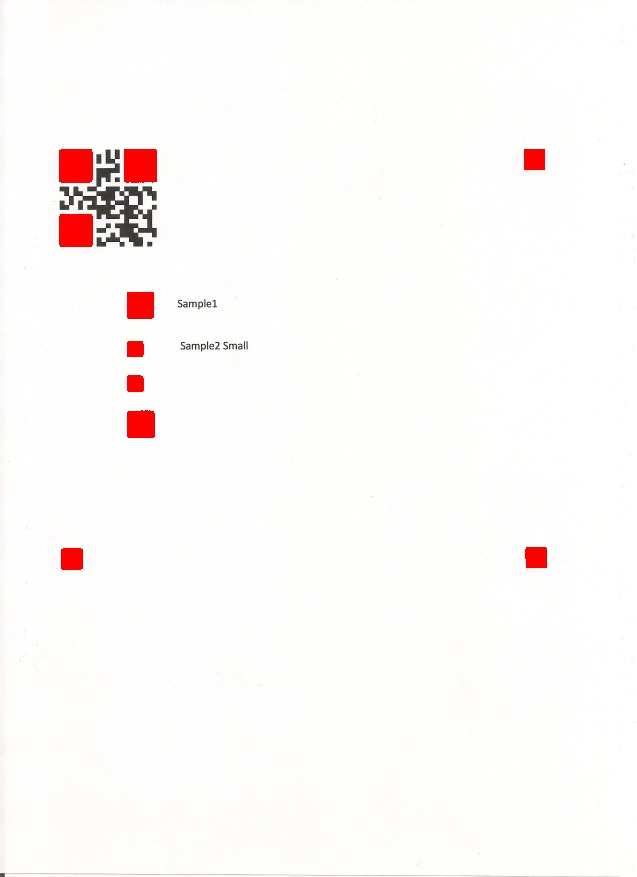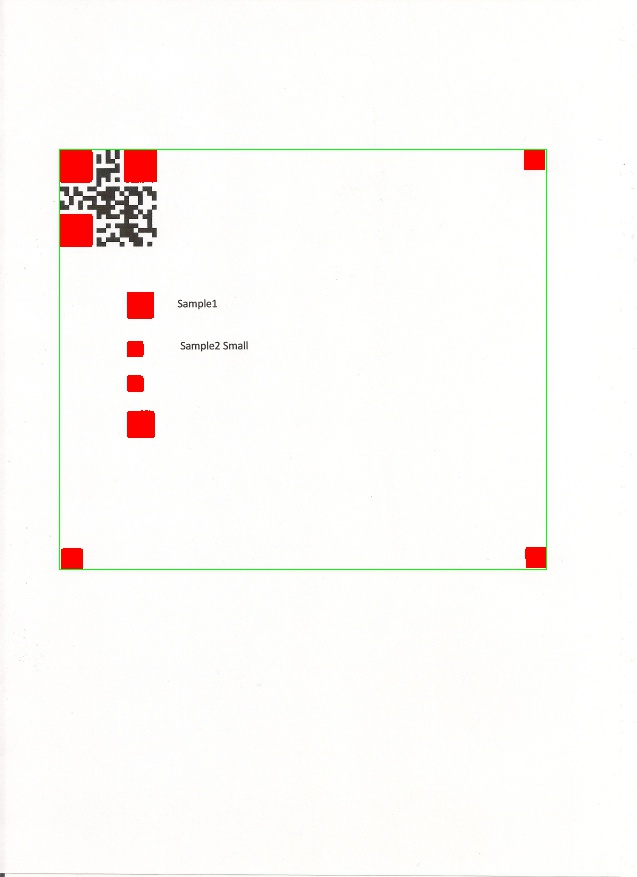This forum is disabled, please visit https://forum.opencv.org
 | 1 | initial version |
i simplified the sample code as below. i hope it helps you.
#include <opencv2/highgui/highgui.hpp>
#include <opencv2/imgproc/imgproc.hpp>
using namespace cv;
using namespace std;
/**
* Helper function to find a cosine of angle between vectors
* from pt0->pt1 and pt0->pt2
*/
static double angle(Point pt1, Point pt2, Point pt0)
{
double dx1 = pt1.x - pt0.x;
double dy1 = pt1.y - pt0.y;
double dx2 = pt2.x - pt0.x;
double dy2 = pt2.y - pt0.y;
return (dx1*dx2 + dy1*dy2)/sqrt((dx1*dx1 + dy1*dy1)*(dx2*dx2 + dy2*dy2) + 1e-10);
}
int main( int argc, char** argv )
{
Mat img = imread(argv[1]);
if (img.empty())
return -1;
Mat src,gray;
resize(img, src, Size(img.cols/2, img.rows/2));
cvtColor(src, gray, CV_BGR2GRAY); // Convert to grayscale
// Use Canny instead of threshold to catch squares with gradient shading
Mat bw;
Canny(gray, bw, 0, 50, 5);
// Find contours
vector<vector<Point> > contours;
findContours(bw.clone(), contours, CV_RETR_EXTERNAL, CV_CHAIN_APPROX_SIMPLE);
vector<Point> approx;
Mat dst = src.clone();
for (int i = 0; i < contours.size(); i++)
{
// Approximate contour with accuracy proportional
// to the contour perimeter
approxPolyDP(Mat(contours[i]), approx, arcLength(Mat(contours[i]), true)*0.02, true);
// Skip small or non-convex objects
if (fabs(contourArea(contours[i])) < 100 || !isContourConvex(approx))
continue;
if (approx.size() == 4 )
{
// Number of vertices of polygonal curve
int vtc = approx.size();
// Get the cosines of all corners
vector<double> cos;
for (int j = 2; j < vtc+1; j++)
cos.push_back(angle(approx[j%vtc], approx[j-2], approx[j-1]));
// Sort ascending the cosine values
sort(cos.begin(), cos.end());
// Get the lowest and the highest cosine
double mincos = cos.front();
double maxcos = cos.back();
if (vtc == 4 && mincos >= -0.1 && maxcos <= 0.3)
{
drawContours( src, contours, i, Scalar(0,0,255), CV_FILLED, 8 );
}
}
}
imshow("src", src);
waitKey(0);
return 0;
}

 | 2 | No.2 Revision |
i simplified the sample code as below. i hope it helps you.you. also look this
#include <opencv2/highgui/highgui.hpp>
#include <opencv2/imgproc/imgproc.hpp>
using namespace cv;
using namespace std;
/**
* Helper function to find a cosine of angle between vectors
* from pt0->pt1 and pt0->pt2
*/
static double angle(Point pt1, Point pt2, Point pt0)
{
double dx1 = pt1.x - pt0.x;
double dy1 = pt1.y - pt0.y;
double dx2 = pt2.x - pt0.x;
double dy2 = pt2.y - pt0.y;
return (dx1*dx2 + dy1*dy2)/sqrt((dx1*dx1 + dy1*dy1)*(dx2*dx2 + dy2*dy2) + 1e-10);
}
int main( int argc, char** argv )
{
Mat img = imread(argv[1]);
if (img.empty())
return -1;
Mat src,gray;
resize(img, src, Size(img.cols/2, img.rows/2));
cvtColor(src, gray, CV_BGR2GRAY); // Convert to grayscale
// Use Canny instead of threshold to catch squares with gradient shading
Mat bw;
Canny(gray, bw, 0, 50, 5);
// Find contours
vector<vector<Point> > contours;
findContours(bw.clone(), contours, CV_RETR_EXTERNAL, CV_CHAIN_APPROX_SIMPLE);
vector<Point> approx;
Mat dst = src.clone();
for (int i = 0; i < contours.size(); i++)
{
// Approximate contour with accuracy proportional
// to the contour perimeter
approxPolyDP(Mat(contours[i]), approx, arcLength(Mat(contours[i]), true)*0.02, true);
// Skip small or non-convex objects
if (fabs(contourArea(contours[i])) < 100 || !isContourConvex(approx))
continue;
if (approx.size() == 4 )
{
// Number of vertices of polygonal curve
int vtc = approx.size();
// Get the cosines of all corners
vector<double> cos;
for (int j = 2; j < vtc+1; j++)
cos.push_back(angle(approx[j%vtc], approx[j-2], approx[j-1]));
// Sort ascending the cosine values
sort(cos.begin(), cos.end());
// Get the lowest and the highest cosine
double mincos = cos.front();
double maxcos = cos.back();
if (vtc == 4 && mincos >= -0.1 && maxcos <= 0.3)
{
drawContours( src, contours, i, Scalar(0,0,255), CV_FILLED, 8 );
}
}
}
imshow("src", src);
waitKey(0);
return 0;
}

 | 3 | No.3 Revision |
i simplified the sample code as below. i hope it helps you. also look this and this
#include <opencv2/highgui/highgui.hpp>
#include <opencv2/imgproc/imgproc.hpp>
using namespace cv;
using namespace std;
/**
* Helper function to find a cosine of angle between vectors
* from pt0->pt1 and pt0->pt2
*/
static double angle(Point pt1, Point pt2, Point pt0)
{
double dx1 = pt1.x - pt0.x;
double dy1 = pt1.y - pt0.y;
double dx2 = pt2.x - pt0.x;
double dy2 = pt2.y - pt0.y;
return (dx1*dx2 + dy1*dy2)/sqrt((dx1*dx1 + dy1*dy1)*(dx2*dx2 + dy2*dy2) + 1e-10);
}
int main( int argc, char** argv )
{
Mat img = imread(argv[1]);
if (img.empty())
return -1;
Mat src,gray;
resize(img, src, Size(img.cols/2, img.rows/2));
cvtColor(src, gray, CV_BGR2GRAY); // Convert to grayscale
// Use Canny instead of threshold to catch squares with gradient shading
Mat bw;
Canny(gray, bw, 0, 50, 5);
// Find contours
vector<vector<Point> > contours;
findContours(bw.clone(), contours, CV_RETR_EXTERNAL, CV_CHAIN_APPROX_SIMPLE);
vector<Point> approx;
Mat dst = src.clone();
for (int i = 0; i < contours.size(); i++)
{
// Approximate contour with accuracy proportional
// to the contour perimeter
approxPolyDP(Mat(contours[i]), approx, arcLength(Mat(contours[i]), true)*0.02, true);
// Skip small or non-convex objects
if (fabs(contourArea(contours[i])) < 100 || !isContourConvex(approx))
continue;
if (approx.size() == 4 )
{
// Number of vertices of polygonal curve
int vtc = approx.size();
// Get the cosines of all corners
vector<double> cos;
for (int j = 2; j < vtc+1; j++)
cos.push_back(angle(approx[j%vtc], approx[j-2], approx[j-1]));
// Sort ascending the cosine values
sort(cos.begin(), cos.end());
// Get the lowest and the highest cosine
double mincos = cos.front();
double maxcos = cos.back();
if (vtc == 4 && mincos >= -0.1 && maxcos <= 0.3)
{
drawContours( src, contours, i, Scalar(0,0,255), CV_FILLED, 8 );
}
}
}
imshow("src", src);
waitKey(0);
return 0;
}

 | 4 | No.4 Revision |
i simplified the sample code as below. i hope it helps you. also look this and this
#include <opencv2/highgui/highgui.hpp>
#include <opencv2/imgproc/imgproc.hpp>
using namespace cv;
using namespace std;
/**
* Helper function to find a cosine of angle between vectors
* from pt0->pt1 and pt0->pt2
*/
static double angle(Point pt1, Point pt2, Point pt0)
{
double dx1 = pt1.x - pt0.x;
double dy1 = pt1.y - pt0.y;
double dx2 = pt2.x - pt0.x;
double dy2 = pt2.y - pt0.y;
return (dx1*dx2 + dy1*dy2)/sqrt((dx1*dx1 + dy1*dy1)*(dx2*dx2 + dy2*dy2) + 1e-10);
}
int main( int argc, char** argv )
{
Mat img = imread(argv[1]);
if (img.empty())
return -1;
Mat src,gray;
resize(img, src, Size(img.cols/2, img.rows/2));
cvtColor(src, gray, CV_BGR2GRAY); // Convert to grayscale
// Use Canny instead of threshold to catch squares with gradient shading
Mat bw;
Canny(gray, bw, 0, 50, 5);
// Find contours
vector<vector<Point> > contours;
findContours(bw.clone(), contours, CV_RETR_EXTERNAL, CV_CHAIN_APPROX_SIMPLE);
vector<Point> squares;
vector<Point> approx;
Mat dst = src.clone();
for (int i = 0; i < contours.size(); i++)
{
// Approximate contour with accuracy proportional
// to the contour perimeter
approxPolyDP(Mat(contours[i]), approx, arcLength(Mat(contours[i]), true)*0.02, true);
// Skip small or non-convex objects
if (fabs(contourArea(contours[i])) < 100 || !isContourConvex(approx))
continue;
if (approx.size() == 4 )
{
// Number of vertices of polygonal curve
int vtc = approx.size();
// Get the cosines of all corners
vector<double> cos;
for (int j = 2; j < vtc+1; j++)
cos.push_back(angle(approx[j%vtc], approx[j-2], approx[j-1]));
// Sort ascending the cosine values
sort(cos.begin(), cos.end());
// Get the lowest and the highest cosine
double mincos = cos.front();
double maxcos = cos.back();
if (vtc == 4 && mincos >= -0.1 && maxcos <= 0.3)
{
for(int j=0; j<4 ;j++ ) // to find topmost,bottommost,rightmost,leftmost contours
squares.push_back(approx[j]); // here all points accumulated first
drawContours( src, contours, i, Scalar(0,0,255), CV_FILLED, 8 );
}
}
}
Rect box = boundingRect(Mat(squares)); // finds outer rectangle of contours
rectangle(src,box,Scalar(0,255,0),1);
imshow("src", src);
waitKey(0);
return 0;
}

